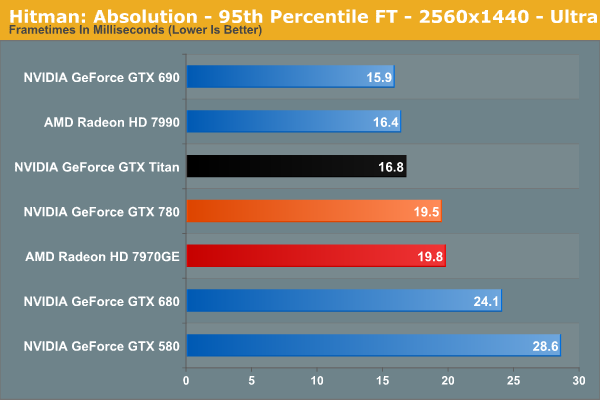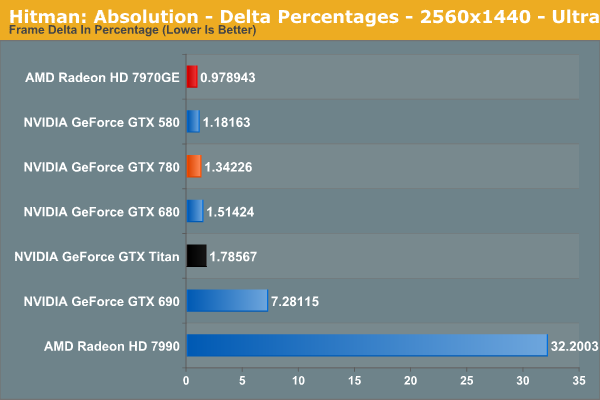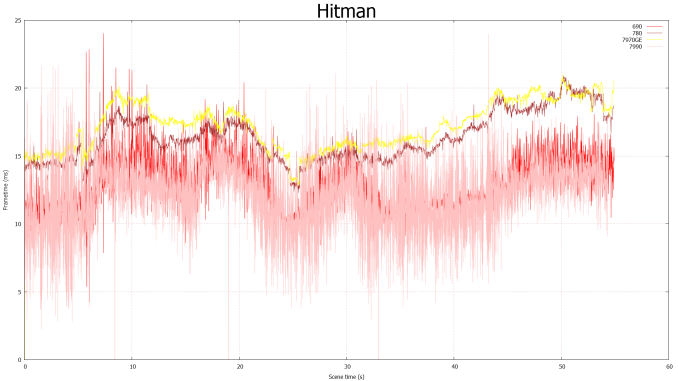NVIDIA GeForce GTX 780 Review: The New High End
by Ryan Smith on May 23, 2013 9:00 AM ESTOur First FCAT & The Test
First announced back at the end of March, FCAT has been something of a bewildering experience for us. NVIDIA has actually done a great job on the software, but between picky games, flaky DVI cables, and dead SSDs (we killed an Intel enterprise grade SSD 910 with FCAT) things have not gone quite to plan, pushing back our intended use of FCAT more than once. In any case, with most of the kinks worked out we’re ready to start integrating it into our major GPU reviews.
For the time being we’re putting FCAT on beta status, as we intend to try out a few different methods of presenting data to find something that’s meaningful, useful, and legible. To that end we’d love to get your feedback in our comments section so that we can further iterate on our presentation and data collection.
We’ve decided to go with two metrics for our first run with FCAT. The first metric is rather simple: 95th percentile frametimes. For years we’ve done minimum framerates (when practical), which are similar in concept, so this allows us to collect similar stats at the end of the rendering pipeline while hopefully avoiding some of the quirkiness that comes from looking at minimum framerates within games themselves. The 95th percentile frametime is quite simply the amount of time it takes to render the slowest 5% of frames. If a game or video card is introducing significant one-off stuttering by taking too long to render some frames, this will show us.

This is primarily meant to capture single-GPU issues, but in practice with AMD having fixed the bulk of their single-GPU issues months ago, we don’t actually expect much. None the less it’s a good way of showing that nothing interesting is happening in those situations.
Our second metric is primarily focused on multi-GPU setups, and is an attempt to quantize the wild frametime variations seen at times with multi-GPU setups, which show up as telltale zigzag lines in frametime graphs.
In this metric, which for the moment we’re calling Delta Percentages, we’re collecting the deltas (differences) between frametimes, averaging that out, and then running the delta average against the average frametime of the entire run. The end result of this process is that we can measure whether sequential frames are rendering in roughly the same amount of time, while controlling for performance differences by looking at the data relative to the average frametime (rather than as absolute time).

In general, a properly behaving single-GPU card should have a delta average of under 3%, with the specific value depending in part on how variable the workload is throughout any given game benchmark. 3% may sound small, but since we’re talking about an average it means it’s weighed against the entire run. The higher the percentage the more unevenly frames are arriving, and exceeding 3% is about where we expect players with good eyes to start noticing a difference. Alternatively in a perfectly frame metered situation, such as v-sync enabled with a setup that can always hit 60fps, then this would be a flat 0%, representing the pinnacle of smoothness.
Moving on, we’ll be running FCAT against 6 of our 10 games for the time being: Sleeping Dogs, Hitman: Absolution, Total War: Shogun 2, Battlefield 3, Bioshock, and Crysis 3. The rest of our games are either highly inconsistent or generally fussy, introducing too much variance into our FCAT results.
Finally, due to the amount of additional time it takes to put together FCAT results, we’re going to primarily publish FCAT results with major product launches and major driver updates. Due to how frame metering works, the only time frame consistency significantly changes is either with the introduction of new architectures/GPUs, or with the introduction of significant driver changes, so those are the scenarios we’ll be focusing on.
The Test
NVIDIA’s launch drivers for the GTX 780 are 320.18, drivers that are essentially identical to the public 320.14 drivers released last week.
| CPU: | Intel Core i7-3960X @ 4.3GHz |
| Motherboard: | EVGA X79 SLI |
| Power Supply: | Antec True Power Quattro 1200 |
| Hard Disk: | Samsung 470 (256GB) |
| Memory: | G.Skill Ripjaws DDR3-1867 4 x 4GB (8-10-9-26) |
| Case: | Thermaltake Spedo Advance |
| Monitor: | Samsung 305T |
| Video Cards: |
AMD Radeon HD 7970 GHz Edition AMD Radeon HD 7990 NVIDIA GeForce GTX 580 NVIDIA GeForce GTX 680 NVIDIA GeForce GTX 690 NVIDIA GeForce GTX 780 NVIDIA GeForce GTX Titan |
| Video Drivers: |
NVIDIA ForceWare 320.14 NVIDIA ForceWare 320.18 AMD Catalyst 13.5 Beta 2 |
| OS: | Windows 8 Pro |











155 Comments
View All Comments
Akrovah - Friday, May 24, 2013 - link
Oh yeah, forgot audio data, all of which gets stored in main RAM. And THAT will take up a pretty nice chunk of space righ there.Sivar - Thursday, May 23, 2013 - link
You realize, of course, that the 8GB RAM in consoles is 8GB *TOTAL* RAM, whose capacity and bandwidth must be shared for video tasks, the OS, and shuffling the game's data files.A PC with a 3GB video card can use that 3GB exclusively for textures and other video card stuff.
B3an - Friday, May 24, 2013 - link
See my comment above.DanNeely - Thursday, May 23, 2013 - link
Right now all we've got is the reference card being rebadged by a half dozenish companies. Give it a few weeks or a month and I'm certain someone will start selling a 6GB model. People gaming at 2560 or on 3 monitor setups might benefit from the wait; people who just want to crank AA at 1080p or even just be able to always play at max instead of fiddling with settings (and there're a lot more of them than there are of us) have no real reason to wait. Also, in 12 months Maxwell will be out and with the power of a die shrink behind it the 860 will probably be able to match what the 780 does anyway.DanNeely - Tuesday, May 28, 2013 - link
On HardOCP's forum I've read that nVidia's told it's partners they shouldn't make a 6GB variant of the 780 (presumably to protect Titan sales). While it's possible one of them might do so anyway; getting nVidia mad at them isn't a good business strategy so it's doubtful any will.tipoo - Thursday, May 23, 2013 - link
If a slightly cut down Titan is their solution for the higher end 700 series card, I wonder what else the series will be like? Will everything just plop down a price category, the 680 in the 670s price point, etc? That would be uninteresting, but reasonable I guess, given how much power Kepler has on tap. And it wouldn't do much for mobile.DigitalFreak - Thursday, May 23, 2013 - link
The 770 will be identical to the 680, but with a slightly faster clock speed. I believe the same will be true with the 760 / 670. Those cards are probably still under NDA, which is why they weren't mentioned.chizow - Thursday, May 23, 2013 - link
Yep 770 at least is supposed to launch a week from today, 5/30. Satisfy demand from the top-down and grab a few impulse buyers who can't wait along the way.yannigr - Thursday, May 23, 2013 - link
No free games. With an AMD card you also get many AAA games. So Nvidia is a little more expensive than just +$200 compared with 7970GE.I am expecting reviewers someday to stop ignoring game bundles because they come from AMD. We are not talking for one or two games here, for old games, or demos. We are talking about MONEY. 6-7-8-9-10 free AAA titles are MONEY.
Tuvok86 - Thursday, May 23, 2013 - link
I believe nVidia has bundles as well